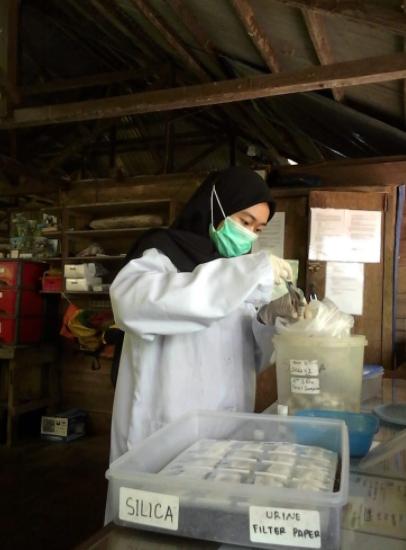
Project Overview
Our project has developed non-invasive methods for monitoring orangutan physiology, energy balance, and health. We use orangutan urine and fecal samples to measure disease and health parameters. We use urinary dipstick analysis to test for ketones as a rapid indicator of health and nutrient depletion. Ketones are produced during fat breakdown occurring during periods of weight loss. We detect ketones in the urine of wild orangutans during periods of low caloric intake. We also helped to pioneer a new technique to measure C-peptide in urine, which contextualizes stress and glucocorticoid responses in wild non-human primates. Our research project provided the first thorough validation of urinary C-peptide as a measure of energy balance in wild primates to demonstrate that orangutans’ monthly C-peptide averages correlate positively with fruit availability and estimated caloric intake.
In 2013, our research project began analyzing fecal samples for parasites in Gunung Palung National Park. We established patterns of parasite prevalence and species richness during a period of fruit abundance. We have continued parasite monitoring, comparing periods of high and low fruit abundance to assess how changing ecology and energetic status influence parasite infection. Some parasite taxa may increase during low fruit compared to high fruit periods (Enterobius sp.), while others increase in certain age-sex classes (Trichuris sp.). We continue to evaluating parasite dynamics over time, in conjunction with other health measures, to investigate how changing environmental conditions and anthropogenic factors impact orangutan health.
Related Publications & Presentations
Knott, CD, AM Scott, CA O’Connell, TW Susanto, & EE Kane (in press). Field Laboratories for Non Invasive Wildlife and Habitat Health Assessment and Conservation. In: S. A. Wich, & A. K. Piel, (Eds.), Field Methods for Conservation. Oxford, England: Oxford University Press.
Malbouf, BB, EE Kane, LS Durgavich, & CD Knott. (2020). A comparison of specific gravity and creatinine for determining urine concentrations in captive orangutans for monitoring health status and physiology. 89th Annual Meeting of the American Association of Physical Anthropologists. American Journal of Physical Anthropology, 171, 171.
Syainullah M, FS Harwell, R Gotama, Junardi, KS Scott, B Philp, TW Susanto, T Mitra Setia, and CD Knott. (2019). Fecal Temperature of Wild and Captive Bornean Orangutans (Pongo pygmaeus wurmbii) as a Proxy for Body Temperature. International Conference on Biodiversity for Life: Sustainable Development of Indonesia Biodiversity. National University, Jakarta, Indonesia
O’Connell, CA. N Robinson, IF Karimah, TW Sustanto, I Foitova, & CD Knott. (2020). The socioecology of parasite infection in wild Bornean orangutans (Pongo pygmaeus wurmbii) in Gunung Palung National Park, West Kalimantan, Indonesia. 89th Annual Meeting of the American Association of Physical Anthropologists. American Journal of Physical Anthropology, 171, 203.
Vogel ER, CD Knott, BE Crowley, MD Blakely, MD Larsen, and NJ Dominy. (2012). Bornean Orangutans at the Brink of Protein Bankruptcy. Biology Letters. (8) 333-336.
Vogel ER, BC Crowley, CD Knott, MD Blakely, MD Larsen and NJ Dominy. (2012). A Non Invasive Method for Measuring Nitrogen Balance in Free–Ranging Primates. International Journal of Primatology. 33: 567-587.
Emery Thompson M and CD Knott. (2008). Urinary C–Peptide of Insulin as a Non–Invasive Measure of Energy Balance in Wild Orangutans. Hormones and Behavior. 53: 526–534.
Knott CD. (2005). Radioimmunoassay of Estrone Conjugates from Urine Dried on Filter Paper. American Journal of Primatology. 67:(1), 121–135.
Knott CD. (1996). Field Collection and Preservation of Urine in Orangutans and Chimpanzees. Tropical Biodiversity. 4(1): 95–102.
